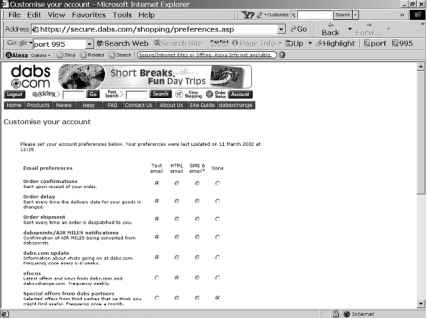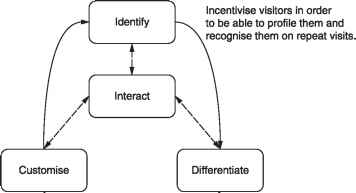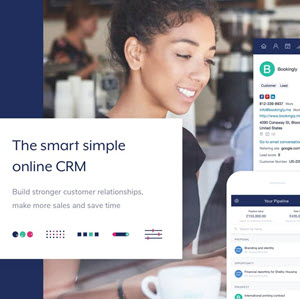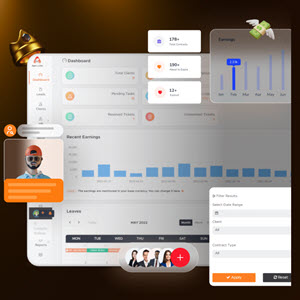Customer retention and extension
Customer retention refers to the strategies and actions that an organisation uses to keep existing customers or to reduce churn. For e-marketers, an important aspect of retention is continuing the customer dialogue using e-mail to encourage repeat visits to a web site. Retention also involves learning more about the customers through their behaviour or through marketing research.
Once an e-mail address has been collected, the e-mail can be used to communicate with the customer in a variety of ways. While using a campaign to a house list to encourage repeat sales is typical, e-mail can also be used to inform customers about new products and events, and also to learn by inviting them to participate in online surveys.
We will review in detail in Chapter 4 how e-mail techniques such as e-newsletters can be used to assist customer retention.
The phase of customer extension refers to increasing the depth or range of products that a customer purchases from a company. For example, an online bank may initially acquire a customer through the use of a credit card. The relationship will be extended if the customer can be persuaded to purchase other financial services such as loans or insurance.
We summarise this section on the customer lifecycle by reviewing the guidance provided by Peppers and Rogers (1993) in The One-to-One Future on how to prioritise activity in different phases of the customer lifecycle. They say:
• Focus on share of the customer as well as market share: this means increasing the revenue from each customer as far as possible.
• Focus on customer retention, which is more cost-effective than acquisition.
• Concentrate on repeat purchases by cross- and up-selling; these also help margins increase.
• To achieve the above use dialogue at all stages to listen to customer needs and then respond to them in order to build trusting and loyal relationships.
CRM: A HEALTH WARNING
Many organisations have bought into the CRM concept, and over the past few years many large-scale CRM programmes have been initiated. Not all have been as successful as that for Deutsche Bank, however: estimates suggest that 70-80% fail.
Many of these failures can be explained away by difficulties in implementation: failure is commonplace for many large-scale, IT-enabled projects, requiring changes in existing processes. A survey by PricewaterhouseCoopers (2001) of chief information officers in 'Top 500' companies in the UK, the USA and Australia showed that one-third of companies had experienced a delay in or scrapping of a new information system. However, such is the volume of failed CRM projects that not all can be ascribed to failures in implementation. Many are questioning whether there is a more fundamental problem with the CRM concept. This is beginning to affect practice, the scrapping of the Safeway supermarket loyalty scheme in favour of a sales promotion approach being a good example.
As noted in the section on permission marketing, many customers do now want to be managed and cynics would suggest that 'customer relationship management' is simply 'customer management'. With customer management there is a focus on customer profitability and lifetime value. This implies efforts to reduce costs and maximise the number of products purchased by the customer, leading to increased 'share of wallet'. In this case, the relationship seems to favour the company rather than the customer.
Given this, a change in perspective is suggested. If CRM becomes CMR, a customer-managed relationship, then the balance shifts somewhat in favour of the customer. The web site provides relatively low-cost tools to enable customers to manage the relationship in terms of communications received. Figure 2.6 shows how the retailer Dabs.com enables customers to choose the nature of communications with them.
ONLINE CRM
Peppers and Rogers (1998) and Peppers et al. (1999) have suggested the IDIC framework as an approach for using CRM and using the web effectively to form and build relationships (Figure 2.7).
In an e-marketing context, IDIC can be related to these stages of relationship building:
1. Customer Identification. This stresses the need to identify each customer on their first visit and subsequent visits. Common methods for identification are the use of cookies or asking a customer to log on to a site. In subsequent customer contacts, additional customer information should be obtained using a process known as drip irrigation. Since information will become out of date with time, it is important to verify, update and delete customer information.
2. Customer Differentiation. This refers to building a profile to help to segment customers. Appropriate services are then developed for each customer. Examples of such segments include the top customers, non-profitable customers, major customers who have ordered less in recent years and customers who buy more products from competitors.
3. Customer Interaction. These are interactions provided on the web site, such as customer service or creating a tailored product. More generally, customers should listen to the needs and experiences of major customers. Interactions should be through the customer-preferred channel, e.g. by e-mail, by phone or by post.

- Figure 2.6 Dabs.com customer communication options
y/ilVV,
E-MAIL MARKETING FUNDAMENTALS 39
mmmwr
4. Customer Customisation. This refers to dynamic personalisation or mass-customisation of content or e-mails according to the segmentation achieved at the acquisition stage. Approaches to personalisation are explained in the section on retention. This stage also involves further market research to find out whether products can be further tailored to meet customers' needs.
PERSONALISATION AND MASS CUSTOMISATION
Personalisation and mass customisation can be used to tailor information content on a web site, and opt-in e-mail can be used to deliver it to add value and at the same time to remind the customer about a product. Personalisation and mass customisation are terms that are often used interchangeably. In the strict sense, personalisation refers to customisation of information requested by a site customer at an individual level. Mass customisation involves providing tailored content to a group of individuals with similar interests. It uses technology to achieve this at an economic level. An example of mass customisation is when Amazon recommends similar books according to what others in a segment have offered, or when it sends a similar e-mail to customers who had an interest in a particular topic, such as e-commerce.
Mass customisation can range from minor cosmetic choices made by the customer (e.g. the choice of colour, trim and specification available to the customer via the multimedia kiosks in Daewoo's car showrooms) to a collaborative process facilitated by ongoing dialogue. Peppers and Rogers (1993) give the example of Motorola, which could manufacture pagers to any of over 11 million different specifications.

Communicate differentiated proposition. Learn more about customer needs through continuous dialogue, incentivised where necessary.
Place customers in segments and develop differentiated content, offers and possibly products for each group.
Figure 2.7 The IDIC model of customer relationship management
For e-mail marketing, there is a range of options for personalisation, which include variation according to:
• the salutation: this is the most basic level of personalisation and should be offered in all customer communications. It is not generally used for newsletters
• the content: for newsletters and alerts, this can be varied according to user selection. For example, Silicon.com, a news service for IT professionals, enables a range of items to be offered. These can be selected by checking boxes for the type of content. A further method of content personalisation is keyword based. This is offered by analysts such as Gartner, where particular keywords such as 'metrics' can be selected. Forbes.com has offered a keyword-based e-mail service which alerts recipients when a particular company name is covered. For e-mail promotions the content can be personalised for different segments, although it will rarely be personalised on an individual level
• the offer: the offer can be varied according to past behaviour such as amount spent
• the landing page: the landing page of the web page can be personalised if e-mails have been targeted for different segments. Content can also be personalised for individuals if they are already registered on a site. The landing page can use cookies to tailor information to an individual.
Was this article helpful?


